Abstract
Using peripheral blood lymphocytes separated by a Ficoll method and suspended in saline, means of 77-1% (s.d. 5-2) E rosettes (T lymphocytes) and 20-1% (s.d. 6-7) EAC rosettes (B lymphocytes) have been obtained with normal healthy donors. Poorer E-rosette formation resulted from higher centrifugation speeds during the washing of lymphocytes or erythrocytes, insufficient chilling, or rough handling. The presence of 5% albumin in the final mixture stabilized the rosettes and brought a constant subpopulation of B lymphocytes into rosetting. In patients with bronchial carcinoma who, at the time of diagnosis, had E-rosette percentages below 1 s.d. of the mean for normal donors, the length of survival was significantly shorter than in those with normal or high values. The same was true for those in whom null cells were detected. In each case the correlation effect was mainly found in the group of patients with squamous carcinoma.
Full text
PDF

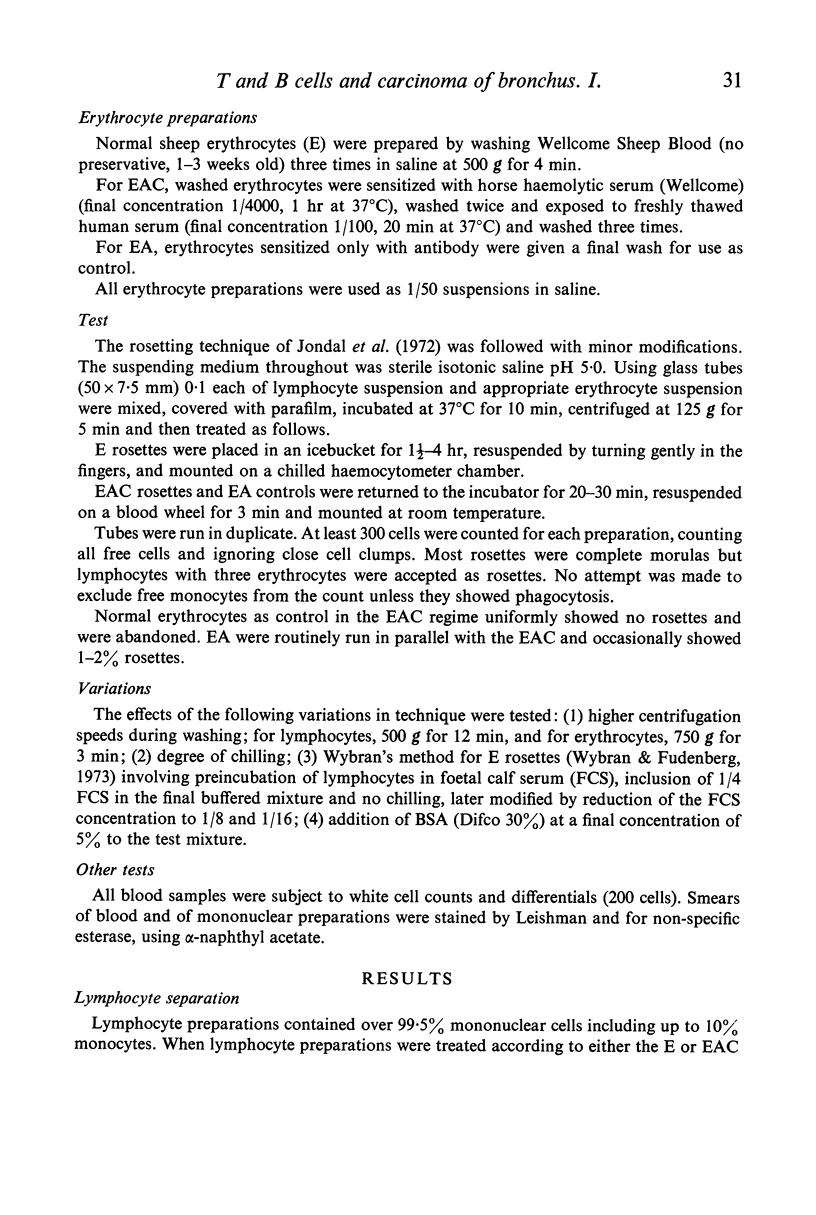


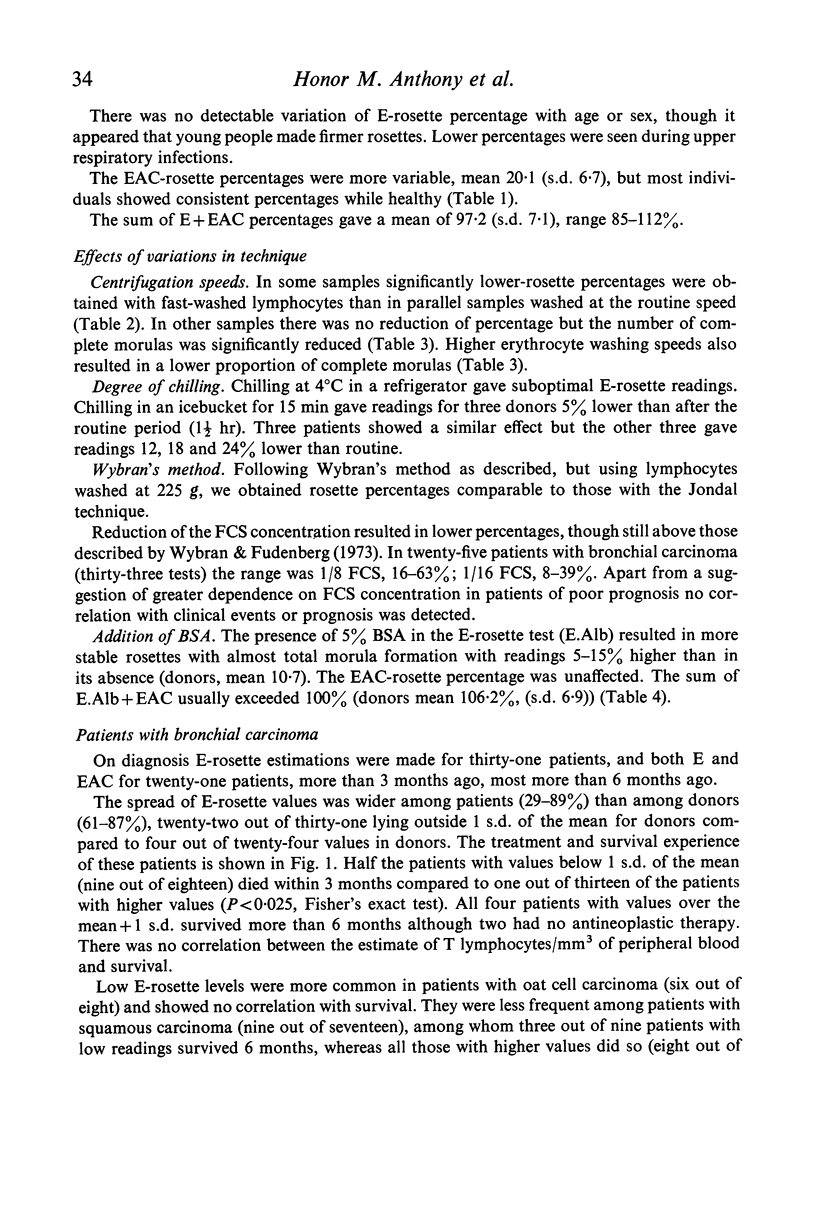
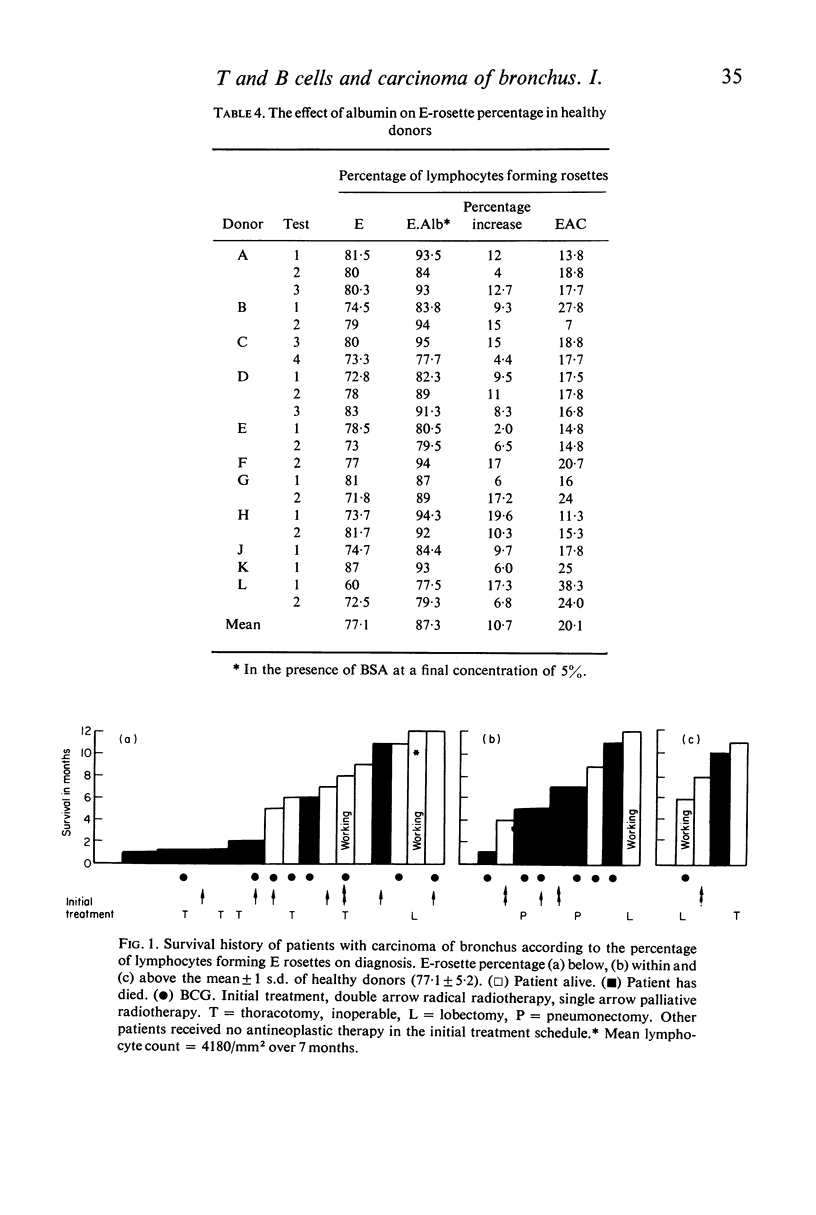
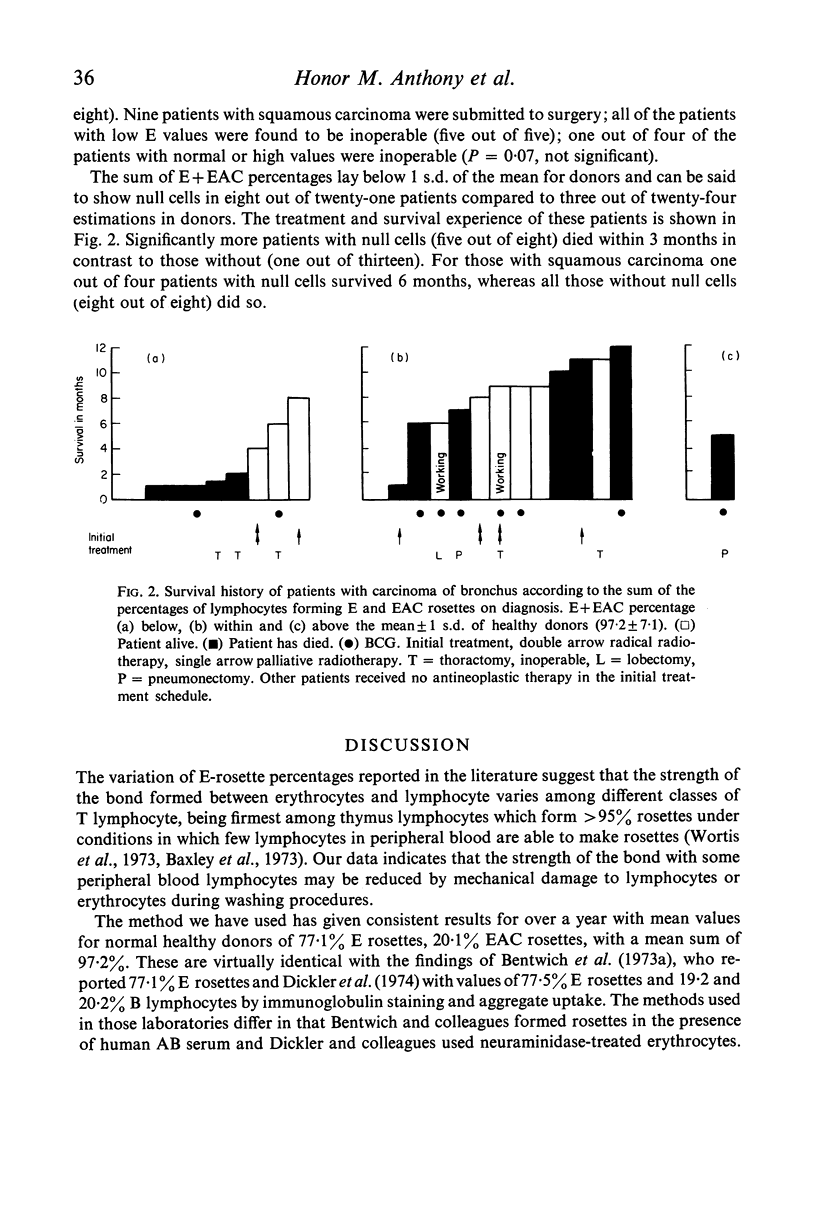


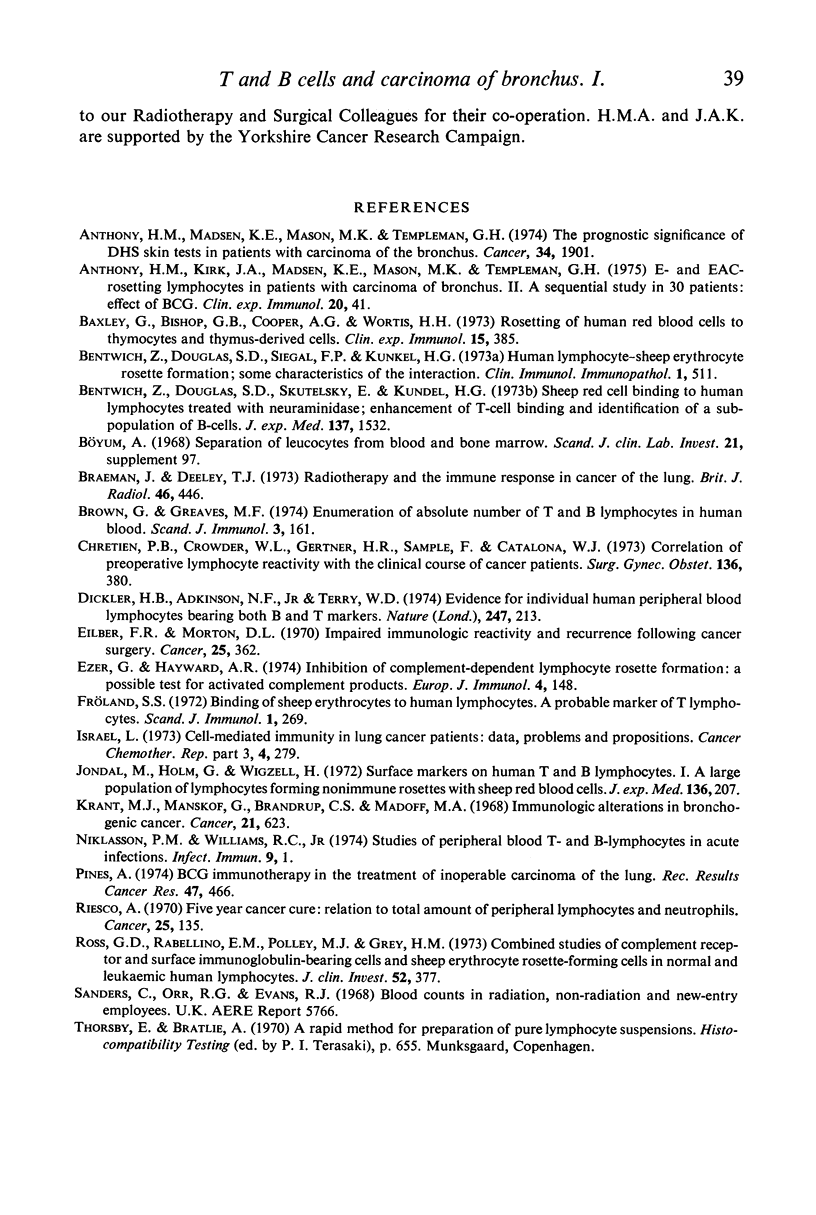
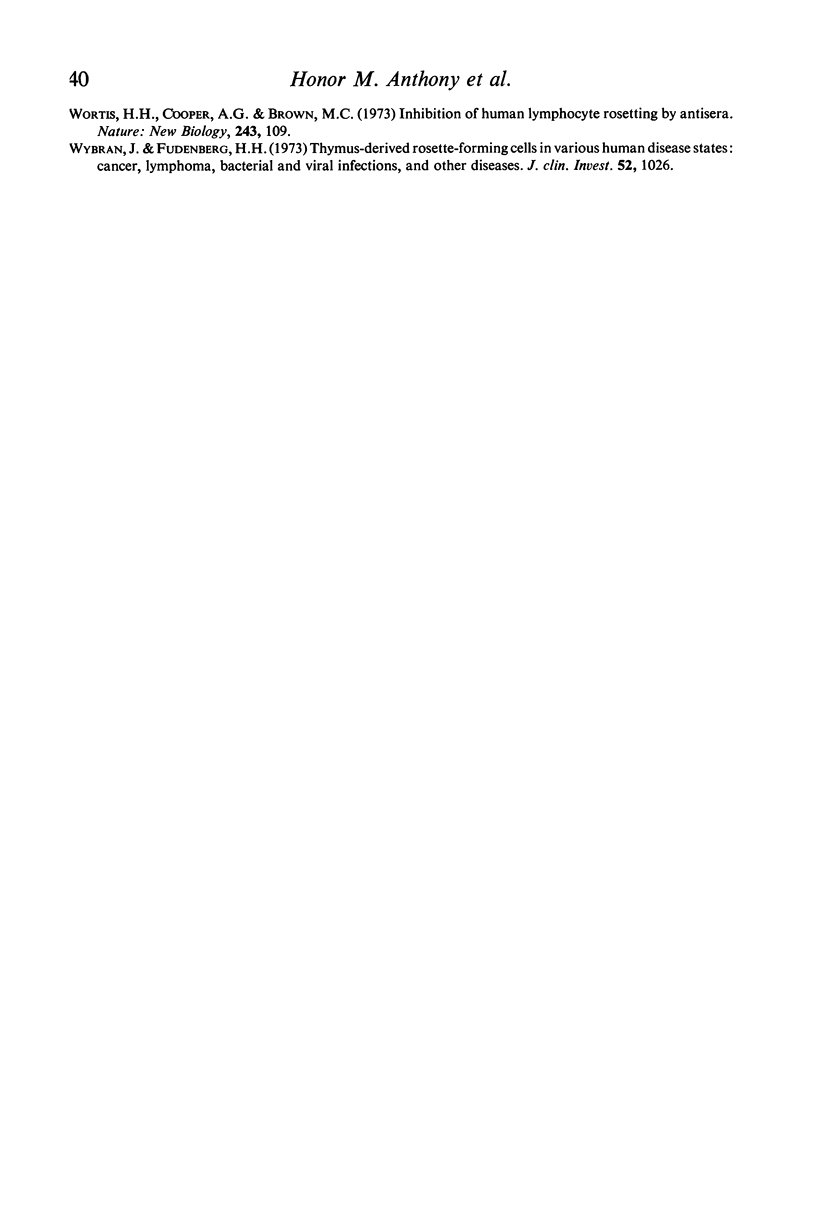
Selected References
These references are in PubMed. This may not be the complete list of references from this article.
- Anthony H. M., Kirk J. A., Madsen K. E., Mason M. K., Templeman G. H. E and EAC rosetting lymphocytes in patients with carcinoma of bronchus. II. A sequential study of thirty patients: effect of BCG. Clin Exp Immunol. 1975 Apr;20(1):41–54. [PMC free article] [PubMed] [Google Scholar]
- Anthony H. M., Templeman G. H., Madsen K. E., Mason M. K. The prognostic significance of DHS skin tests in patients with carcinoma of bronchus. Cancer. 1974 Dec;34(6):1901–1906. doi: 10.1002/1097-0142(197412)34:6<1901::aid-cncr2820340608>3.0.co;2-p. [DOI] [PubMed] [Google Scholar]
- Baxley G., Bishop G. B., Cooper A. G., Wortis H. H. Rosetting of human red blood cells to thymocytes and thymus-derived cells. Clin Exp Immunol. 1973 Nov;15(3):385–392. [PMC free article] [PubMed] [Google Scholar]
- Bentwich Z., Douglas S. D., Siegal F. P., Kunkel H. G. Human lymphocyte-sheep erythrocyte rosette formation: some characteristics of the interaction. Clin Immunol Immunopathol. 1973 Jul;1(4):511–522. doi: 10.1016/0090-1229(73)90007-x. [DOI] [PubMed] [Google Scholar]
- Bentwich Z., Douglas S. D., Skutelsky E., Kunkel H. G. Sheep red cell binding to human lymphocytes treated with neuraminidase; enhancement of T cell binding and identification of a subpopulation of B cells. J Exp Med. 1973 Jun 1;137(6):1532–1537. doi: 10.1084/jem.137.6.1532. [DOI] [PMC free article] [PubMed] [Google Scholar]
- Braeman J., Deeley T. J. Radiotherapy and the immune response in cancer of the lung. Br J Radiol. 1973 Jun;46(546):446–449. doi: 10.1259/0007-1285-46-546-446. [DOI] [PubMed] [Google Scholar]
- Brown G., Greaves M. F. Enumeration of absolute numbers of T and B lymphocytes in human blood. Scand J Immunol. 1974;3(2):161–172. doi: 10.1111/j.1365-3083.1974.tb01244.x. [DOI] [PubMed] [Google Scholar]
- Chretien P. B., Crowder W. L., Gertner H. R., Sample W. F., Catalona W. J. Correlation of preoperative lymphocyte reactivity with the clinical course of cancer patients. Surg Gynecol Obstet. 1973 Mar;136(3):380–384. [PubMed] [Google Scholar]
- Dickler H. B., Adkinson N. F., Jr, Terry W. D. Evidence for individual human peripheral blood lymphocytes bearing both B and T cell markers. Nature. 1974 Jan 25;247(5438):213–215. doi: 10.1038/247213a0. [DOI] [PubMed] [Google Scholar]
- Eilber F. R., Morton D. L. Impaired immunologic reactivity and recurrence following cancer surgery. Cancer. 1970 Feb;25(2):362–367. doi: 10.1002/1097-0142(197002)25:2<362::aid-cncr2820250213>3.0.co;2-v. [DOI] [PubMed] [Google Scholar]
- Ezer G., Hayward A. R. Inhibition of complement-dependent lymphocyte rosette formation: a possible test for activated complement products. Eur J Immunol. 1974 Feb;4(2):148–150. doi: 10.1002/eji.1830040216. [DOI] [PubMed] [Google Scholar]
- Fröland S. S. Binding of sheep erythrocytes to human lymphocytes. A probable marker of T lymphocytes. Scand J Immunol. 1972;1(3):269–280. doi: 10.1111/j.1365-3083.1972.tb01818.x. [DOI] [PubMed] [Google Scholar]
- Israel L. Cell-mediated immunity in lung cancer patients: data, problems, and propositions. Cancer Chemother Rep 3. 1973 Mar;4(2):279–281. [PubMed] [Google Scholar]
- Jondal M., Holm G., Wigzell H. Surface markers on human T and B lymphocytes. I. A large population of lymphocytes forming nonimmune rosettes with sheep red blood cells. J Exp Med. 1972 Aug 1;136(2):207–215. doi: 10.1084/jem.136.2.207. [DOI] [PMC free article] [PubMed] [Google Scholar]
- Krant M. J., Manskopf G., Brandrup C. S., Madoff M. A. Immunologic alterations in bronchogenic cancer. Sequential study. Cancer. 1968 Apr;21(4):623–631. doi: 10.1002/1097-0142(196804)21:4<623::aid-cncr2820210414>3.0.co;2-p. [DOI] [PubMed] [Google Scholar]
- Niklasson P. M., Williams R. C., Jr Studies of peripheral blood T-and B-lymphocytes in acute infections. Infect Immun. 1974 Jan;9(1):1–7. doi: 10.1128/iai.9.1.1-7.1974. [DOI] [PMC free article] [PubMed] [Google Scholar]
- Riesco A. Five-year cancer cure: relation to total amount of peripheral lymphocytes and neutrophils. Cancer. 1970 Jan;25(1):135–140. doi: 10.1002/1097-0142(197001)25:1<135::aid-cncr2820250120>3.0.co;2-9. [DOI] [PubMed] [Google Scholar]
- Ross G. D., Rabellino E. M., Polley M. J., Grey H. M. Combined studies of complement receptor and surface immunoglobulin-bearing cells and sheep erythrocyte rosette-forming cells in normal and leukemic human lymphocytes. J Clin Invest. 1973 Feb;52(2):377–385. doi: 10.1172/JCI107194. [DOI] [PMC free article] [PubMed] [Google Scholar]
- Worth H. H., Cooper A. G., Brown M. C. Inhibition of human lymphocyte rosetting by anti-T sera. Nat New Biol. 1973 May 23;243(125):109–111. [PubMed] [Google Scholar]
- Wybran J., Fudenberg H. H. Thymus-derived rosette-forming cells in various human disease states: cancer, lymphoma, bacterial and viral infections, and other diseases. J Clin Invest. 1973 May;52(5):1026–1032. doi: 10.1172/JCI107267. [DOI] [PMC free article] [PubMed] [Google Scholar]


